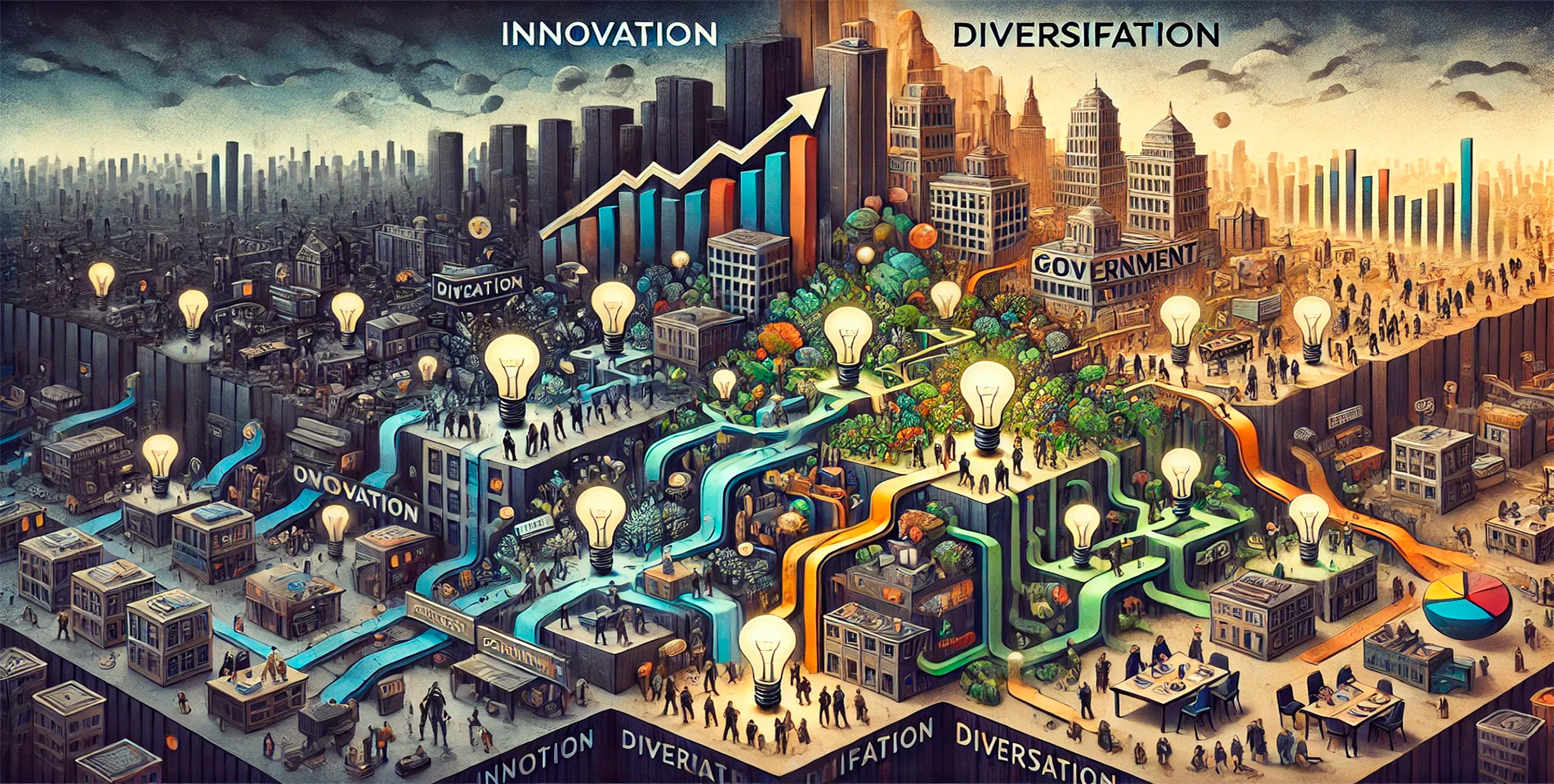Combatting Economic Stagnation: The Path to Growth in Saturated Markets

Economic stagnation often occurs when an economy reaches a state of oversaturation, particularly in the services sector, leading to reduced profitability, lower innovation, and stagnant growth. Oversaturation happens when there is an excess of similar service providers competing for a limited number of customers, resulting in increased competition and diminishing returns. As the market becomes crowded, businesses struggle to differentiate themselves, and the lack of demand for their services stifles growth.
This article explores how economies can overcome stagnation caused by oversaturation and offers strategies to revitalize growth through innovation, diversification, and effective government policies.
Understanding Economic Stagnation and Oversaturation
Economic stagnation occurs when an economy experiences slow or no growth over an extended period. In the context of oversaturation, this stagnation is primarily driven by an excess supply of similar services that outweighs the demand, causing businesses to struggle with low profitability and reducing incentives for growth and expansion. This often leads to a cycle of price-cutting, lowered wages, and minimal investment in innovation.
Oversaturation is common in mature markets, where a high number of businesses compete within the same industry, providing similar products or services. With limited differentiation, customers have little incentive to choose one provider over another, leading to a race to the bottom where businesses lower prices to attract customers, ultimately affecting profitability.
1. Market Competition and Reduced Profit Margins
As more service providers enter the market, competition intensifies. In oversaturated markets, businesses often lower their prices to gain a competitive edge, which can reduce profit margins to unsustainable levels. This lack of profitability prevents businesses from investing in growth or innovation, leading to an overall slowdown in economic progress.
Effects of oversaturation on competition:
- Price wars: Companies compete by undercutting each other’s prices, leading to reduced profit margins for all participants.
- Decreased financial sustainability: The constant pressure to reduce costs affects businesses’ ability to maintain profitability and invest in their operations.
2. Lack of Differentiation and Innovation
Oversaturation also leads to a lack of differentiation, as businesses offer similar products or services without significant variation. This lack of innovation further contributes to economic stagnation, as there is little incentive for companies to create new offerings or invest in research and development (R&D). As a result, industries become stagnant, and growth opportunities diminish.
Consequences of minimal differentiation:
- Customer indifference: When businesses provide identical services, customers have no reason to choose one company over another, leading to reduced brand loyalty.
- Stifled innovation: Without differentiation, businesses are less likely to invest in new technologies or improve their services, reducing overall industry growth.

Strategies to Overcome Economic Stagnation Due to Oversaturation
While oversaturation can lead to economic stagnation, there are several strategies that businesses and governments can employ to revive growth and stimulate innovation. These strategies focus on encouraging diversification, fostering innovation, and implementing policies that support sustainable economic development.
1. Encouraging Diversification in the Market
Diversification is one of the most effective strategies for overcoming economic stagnation due to oversaturation. By diversifying products and services, businesses can reduce their reliance on a single market segment and create new revenue streams. Diversification allows companies to tap into new customer bases, reducing direct competition and mitigating the negative effects of oversaturation.
How diversification stimulates growth:
- Expanding product offerings: Businesses can introduce new products or services that cater to different customer needs, reducing competition within a saturated market.
- Entering new markets: Expanding into new geographic areas or target markets can help businesses reduce their dependence on oversaturated segments and increase overall market share.
2. Fostering Innovation Through R&D Investment
Innovation is a key driver of economic growth and is particularly important for overcoming stagnation in oversaturated markets. By investing in research and development, businesses can create new products, improve existing services, and develop new technologies that set them apart from their competitors. Governments can also play a role by providing grants, tax incentives, and other forms of support for R&D activities.
Ways to foster innovation in oversaturated markets:
- Government incentives for R&D: Governments can offer tax breaks or grants to businesses that invest in developing new products or services, encouraging innovation.
- Collaborative research efforts: Businesses can collaborate with universities or research institutions to develop new technologies that drive industry growth and differentiation.
3. Promoting Sustainable Competition Through Regulation
Effective regulation can help prevent oversaturation by controlling the number of new entrants in certain industries and ensuring fair competition. Governments can implement policies that promote sustainable growth by limiting overinvestment in already saturated sectors, while also encouraging businesses to explore underdeveloped industries. This can help balance supply and demand, reducing the risk of oversaturation and economic stagnation.
Examples of regulatory measures to prevent oversaturation:
- Entry restrictions: Governments can limit the number of new businesses entering a saturated market, reducing the risk of excessive competition.
- Support for emerging industries: By offering incentives for businesses to invest in underdeveloped sectors, governments can encourage diversification and reduce reliance on saturated markets.
4. Supporting Small Businesses and Startups
Small businesses and startups play a critical role in driving economic growth, innovation, and job creation. Supporting these enterprises through access to financing, mentorship, and training can help revive stagnant economies. Startups are often more agile and willing to take risks, which makes them well-suited to explore new opportunities and develop innovative solutions. Governments and financial institutions can support small businesses by providing grants, low-interest loans, and training programs.
How supporting small businesses promotes growth:
- Access to financing: Providing small businesses with access to loans or grants enables them to invest in growth opportunities and innovation.
- Encouraging entrepreneurship: Supporting new startups encourages competition and the development of new ideas, driving economic growth.
5. Investing in Workforce Training and Skill Development
An educated and skilled workforce is essential for driving innovation and economic growth. Investing in workforce training and skill development can help workers adapt to changing market conditions and contribute to new industries. By offering training programs in emerging fields, such as technology and green energy, governments and businesses can create a workforce that is capable of driving growth and diversification, helping to overcome economic stagnation.
Benefits of workforce training for economic growth:
- Adapting to new industries: Training programs can help workers transition to industries that are experiencing growth, reducing reliance on oversaturated sectors.
- Boosting productivity: A skilled workforce is more productive, enabling businesses to innovate and expand, which drives economic growth.

Reviving Growth Through Collaborative Efforts
Reviving growth in an economy that has been affected by oversaturation requires a collaborative effort between businesses, governments, and financial institutions. By working together, these stakeholders can create an environment that supports innovation, encourages diversification, and ensures sustainable competition. Below are some key ways that collaborative efforts can help revive economic growth.
1. Public-Private Partnerships for Innovation
Public-private partnerships (PPPs) can play a crucial role in fostering innovation and economic growth. By collaborating on research projects, infrastructure development, and industry initiatives, governments and private companies can pool resources and expertise to drive growth in emerging industries. These partnerships can help bridge the gap between public funding and private sector innovation, creating new opportunities for growth.
Examples of successful public-private partnerships:
- Research and development collaborations: Governments can partner with private companies to fund research projects that lead to new technologies and products, helping businesses differentiate themselves in a crowded market.
- Infrastructure development: PPPs can be used to develop critical infrastructure, such as transportation and communication networks, that supports business growth and competitiveness.
2. Government-Led Economic Stimulus Programs
During periods of economic stagnation, governments can implement economic stimulus programs to inject capital into the economy and support growth. These programs may include grants, tax incentives, or direct investments in industries that show potential for growth. By targeting sectors that are underdeveloped or have high growth potential, governments can help reduce reliance on oversaturated markets and encourage diversification.
How economic stimulus programs revive growth:
- Targeted investments: Governments can invest in emerging industries, such as green energy or technology, to create new growth opportunities and reduce oversaturation in other sectors.
- Encouraging consumer spending: Stimulus programs that put money in the hands of consumers can help boost demand for goods and services, supporting business growth.
3. Financial Support for Innovation and Diversification
Financial institutions can play a key role in reviving economic growth by providing funding for innovation and diversification. Loans, grants, and investment capital can help businesses explore new opportunities, invest in R&D, and expand into new markets. By providing access to affordable financing, financial institutions can support businesses in overcoming the challenges of oversaturation and driving economic growth.
Ways financial institutions support growth:
- R&D financing: Providing loans or grants for research and development enables businesses to innovate and create differentiated products and services.
- Diversification loans: Financial support for expanding into new markets or introducing new products helps businesses reduce their dependence on oversaturated sectors.
Conclusion
Economic stagnation due to oversaturation is a significant challenge that can hinder growth and reduce profitability for businesses. However, by encouraging diversification, fostering innovation, implementing effective regulations, and supporting small businesses, economies can overcome stagnation and revitalize growth. Collaborative efforts between governments, businesses, and financial institutions are essential for creating an environment that supports sustainable growth and ensures that economies can adapt to changing market conditions.


